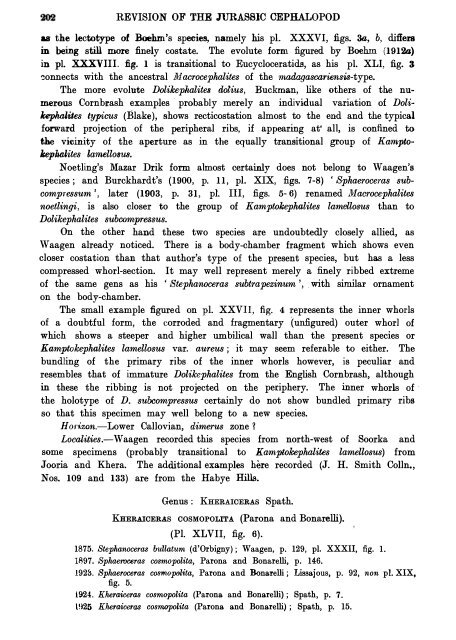ialontolngia ndita,
ialontolngia ndita,
ialontolngia ndita,
Create successful ePaper yourself
Turn your PDF publications into a flip-book with our unique Google optimized e-Paper software.
REVISION OF THE JURASSIC CEPHALOPOD<br />
as the lectotype af Boehm's species, namely his pL XXXVI, figs. 3a, b, diffe:ra<br />
in being still more finely costate. The evolute form :figured by Boehm (1912a)<br />
in pi. XXXVIII. :fig. 1 is transitional to Eucycloceratid.s, as his pi. XLI, fig. 3<br />
':!onnects with the ancestral J.liacrocephalites of the madagascariensis-type.<br />
The more evolute Dolikephalites dolius, Buckman, like others of the numerous<br />
Cornbrash examples · probably merely an individual variation of Dolikephaliles<br />
typicus (Blake), shows recticostation almost to the end and the typical<br />
forward projection of the peripheral ribs, if appearing at' all, is confined to<br />
the vicinity of the aperture as in the equally transitional group of Kamptokephalites<br />
lamellosus.<br />
Noetling's Mazar Drik form almost certainly does not belong to Waagen's<br />
species ; and Burckhardt's {1900, p. 11, pl. XIX, figs. 7-8) 'Sphaeroceras subcomp1·essum<br />
', later (1903, p. 31, pl. Ill, figs. 5- 6) renamed Macrocephalites<br />
noetlingi, is also closer to the group of Kamptokephalites lamellosus than to<br />
Dolikephalites subcompressus.<br />
On the other hand these two species are undoubtedly closely allied, as<br />
W aagen already noticed. There is a body-chamber fragment which shows even<br />
closer costation than that author's type of the present species, but has a less<br />
compressed whorl-section. It may well represent merely a finely ribbed extreme<br />
of the same gens as his ' Stephanoceras subtrapezinum ', . with similar ornament<br />
on the body-chamber.<br />
The small example figured on pl. XXVII, fig. 4 represents the inner whorls<br />
of a doubtful form, the corroded and fragmentary (unfigured) outer whorl of<br />
which shows a steeper and higher umbilical wall than the present species or<br />
Kamptokephalites lamellosus var. aureus ; it may seem referable to either. The<br />
bundling of the primary ribs of the inner whorls however, is peculiar and<br />
resembles that of immature Dolikephalites from the English Cornbrash, although<br />
in these the ribbing is not projected on the periphery. The inner whorls of ·<br />
the holotype of D. subcompressus certainly do not show bundled primary ribs<br />
so that this specimen may well belong to a new species.<br />
Hon:zon.-Lower Callovian, dimerus zone 1<br />
Localities.-Waagen recorded this species from north-west of Soorka and<br />
some specimens (probably transitional to Kamptokephalites lamellosus) from<br />
Jooria and Khera. The additional examples here recorded (J. H. Smith Colln.,<br />
Nos. 109 and 133) are from the Habye Hills.<br />
Genus : KHERAICERAS Spath.<br />
KHERAICERAS COSMOPOLITA (Parona and Bonarelli).<br />
(Pl. XLVII, fig. 6).<br />
1875. Stephanoceras bullatum (d'Orbigny) ; Waagen, p. 129, pi. XXXII, fig. I.<br />
1A.97. Sphaeroceras cosmopolita, Parona and Bonarelli, p. 146.<br />
1923. Sphaeroceras co81tWpolita, Parona and Bonarelli ; Lissajous, p. 92, non pi. XIX,<br />
fig. 5.<br />
l924:. Kheraiceras cosmopolita (Parona and Bonarelli) ; Spath, p. 7.<br />
l!l25 Kheraiceras cosmnpolita (Parona and Bonarelli) ; Spath, p. 15.
















